Physical, Cognitive And Psychosocial Changes During Midlife
VerifiedAdded on 2023/01/16
|9
|3233
|89
AI Summary
This study explores the physical, cognitive, and psychosocial changes that occur during midlife. It discusses the visible physical changes, decline in cognitive abilities, and shifts in social interactions. The effects of aging on the body, memory, attention, and relationships are examined.
Contribute Materials
Your contribution can guide someone’s learning journey. Share your
documents today.
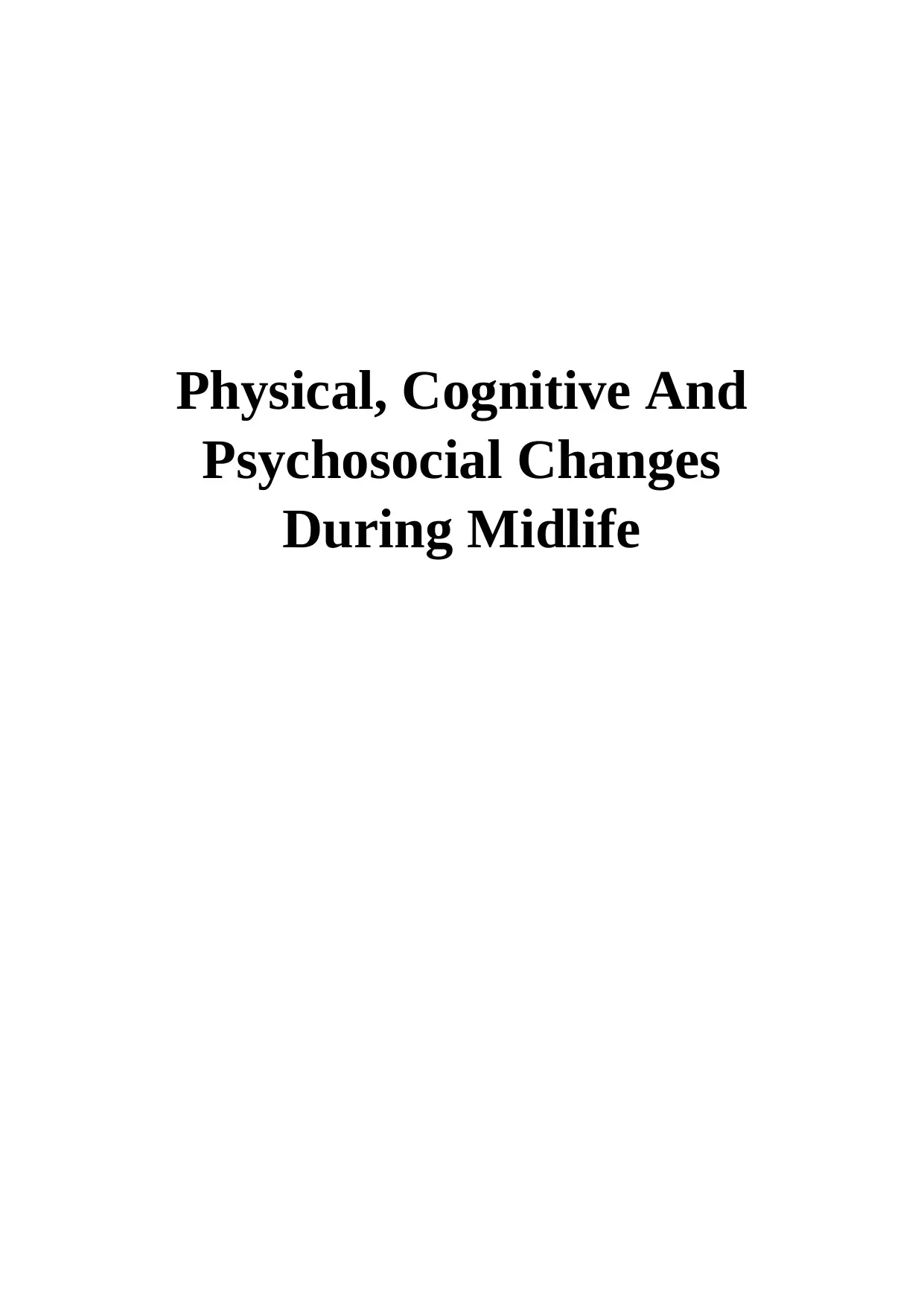
Physical, Cognitive And
Psychosocial Changes
During Midlife
Psychosocial Changes
During Midlife
Secure Best Marks with AI Grader
Need help grading? Try our AI Grader for instant feedback on your assignments.

Contents
INTRODUCTION.................................................................................................................................3
MAIN BODY........................................................................................................................................3
Physical changes................................................................................................................................3
Cognitive changes.............................................................................................................................5
Psychosocial changes........................................................................................................................6
CONCLUSION.....................................................................................................................................8
REFERENCES......................................................................................................................................9
INTRODUCTION.................................................................................................................................3
MAIN BODY........................................................................................................................................3
Physical changes................................................................................................................................3
Cognitive changes.............................................................................................................................5
Psychosocial changes........................................................................................................................6
CONCLUSION.....................................................................................................................................8
REFERENCES......................................................................................................................................9
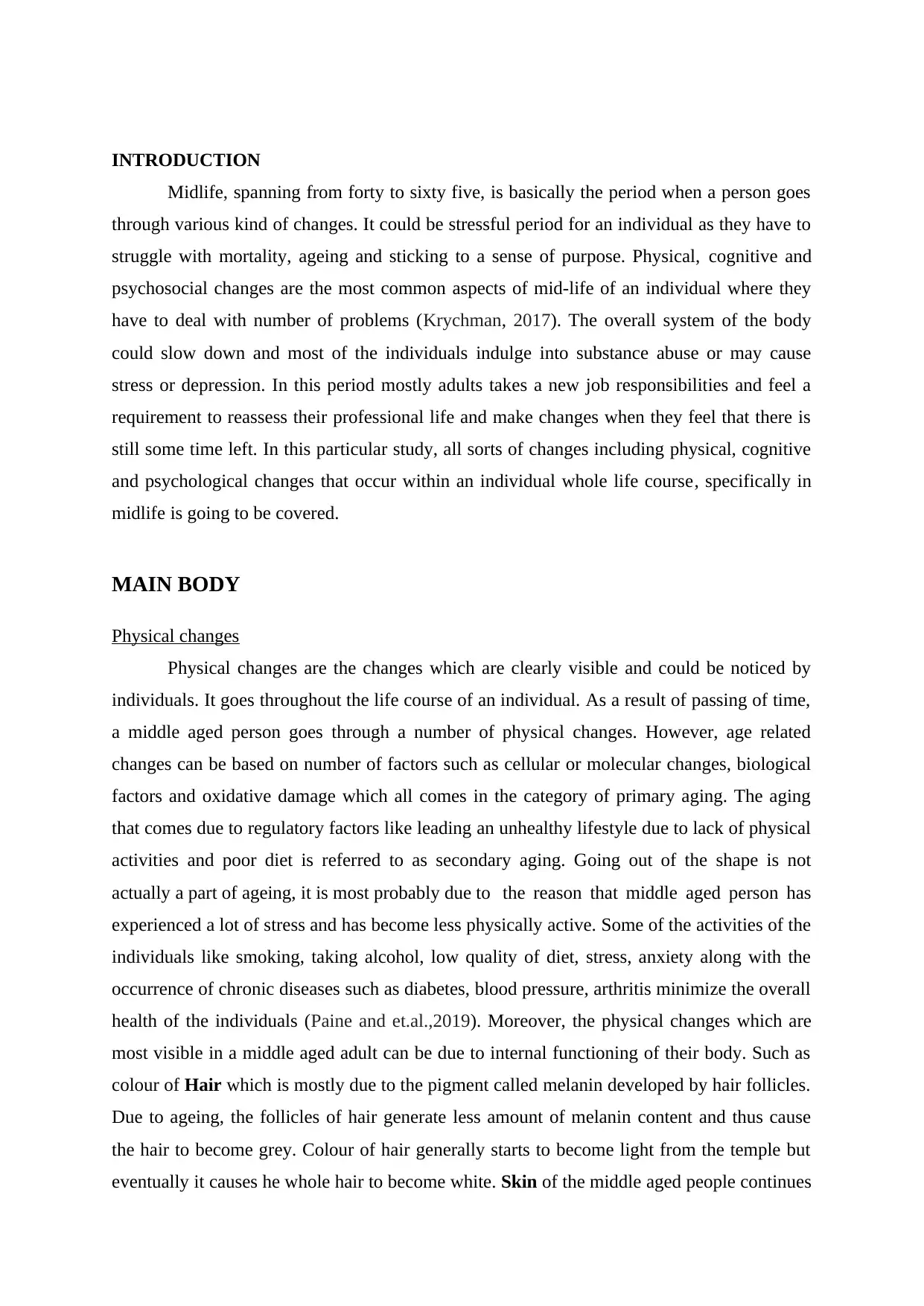
INTRODUCTION
Midlife, spanning from forty to sixty five, is basically the period when a person goes
through various kind of changes. It could be stressful period for an individual as they have to
struggle with mortality, ageing and sticking to a sense of purpose. Physical, cognitive and
psychosocial changes are the most common aspects of mid-life of an individual where they
have to deal with number of problems (Krychman, 2017). The overall system of the body
could slow down and most of the individuals indulge into substance abuse or may cause
stress or depression. In this period mostly adults takes a new job responsibilities and feel a
requirement to reassess their professional life and make changes when they feel that there is
still some time left. In this particular study, all sorts of changes including physical, cognitive
and psychological changes that occur within an individual whole life course, specifically in
midlife is going to be covered.
MAIN BODY
Physical changes
Physical changes are the changes which are clearly visible and could be noticed by
individuals. It goes throughout the life course of an individual. As a result of passing of time,
a middle aged person goes through a number of physical changes. However, age related
changes can be based on number of factors such as cellular or molecular changes, biological
factors and oxidative damage which all comes in the category of primary aging. The aging
that comes due to regulatory factors like leading an unhealthy lifestyle due to lack of physical
activities and poor diet is referred to as secondary aging. Going out of the shape is not
actually a part of ageing, it is most probably due to the reason that middle aged person has
experienced a lot of stress and has become less physically active. Some of the activities of the
individuals like smoking, taking alcohol, low quality of diet, stress, anxiety along with the
occurrence of chronic diseases such as diabetes, blood pressure, arthritis minimize the overall
health of the individuals (Paine and et.al.,2019). Moreover, the physical changes which are
most visible in a middle aged adult can be due to internal functioning of their body. Such as
colour of Hair which is mostly due to the pigment called melanin developed by hair follicles.
Due to ageing, the follicles of hair generate less amount of melanin content and thus cause
the hair to become grey. Colour of hair generally starts to become light from the temple but
eventually it causes he whole hair to become white. Skin of the middle aged people continues
Midlife, spanning from forty to sixty five, is basically the period when a person goes
through various kind of changes. It could be stressful period for an individual as they have to
struggle with mortality, ageing and sticking to a sense of purpose. Physical, cognitive and
psychosocial changes are the most common aspects of mid-life of an individual where they
have to deal with number of problems (Krychman, 2017). The overall system of the body
could slow down and most of the individuals indulge into substance abuse or may cause
stress or depression. In this period mostly adults takes a new job responsibilities and feel a
requirement to reassess their professional life and make changes when they feel that there is
still some time left. In this particular study, all sorts of changes including physical, cognitive
and psychological changes that occur within an individual whole life course, specifically in
midlife is going to be covered.
MAIN BODY
Physical changes
Physical changes are the changes which are clearly visible and could be noticed by
individuals. It goes throughout the life course of an individual. As a result of passing of time,
a middle aged person goes through a number of physical changes. However, age related
changes can be based on number of factors such as cellular or molecular changes, biological
factors and oxidative damage which all comes in the category of primary aging. The aging
that comes due to regulatory factors like leading an unhealthy lifestyle due to lack of physical
activities and poor diet is referred to as secondary aging. Going out of the shape is not
actually a part of ageing, it is most probably due to the reason that middle aged person has
experienced a lot of stress and has become less physically active. Some of the activities of the
individuals like smoking, taking alcohol, low quality of diet, stress, anxiety along with the
occurrence of chronic diseases such as diabetes, blood pressure, arthritis minimize the overall
health of the individuals (Paine and et.al.,2019). Moreover, the physical changes which are
most visible in a middle aged adult can be due to internal functioning of their body. Such as
colour of Hair which is mostly due to the pigment called melanin developed by hair follicles.
Due to ageing, the follicles of hair generate less amount of melanin content and thus cause
the hair to become grey. Colour of hair generally starts to become light from the temple but
eventually it causes he whole hair to become white. Skin of the middle aged people continues
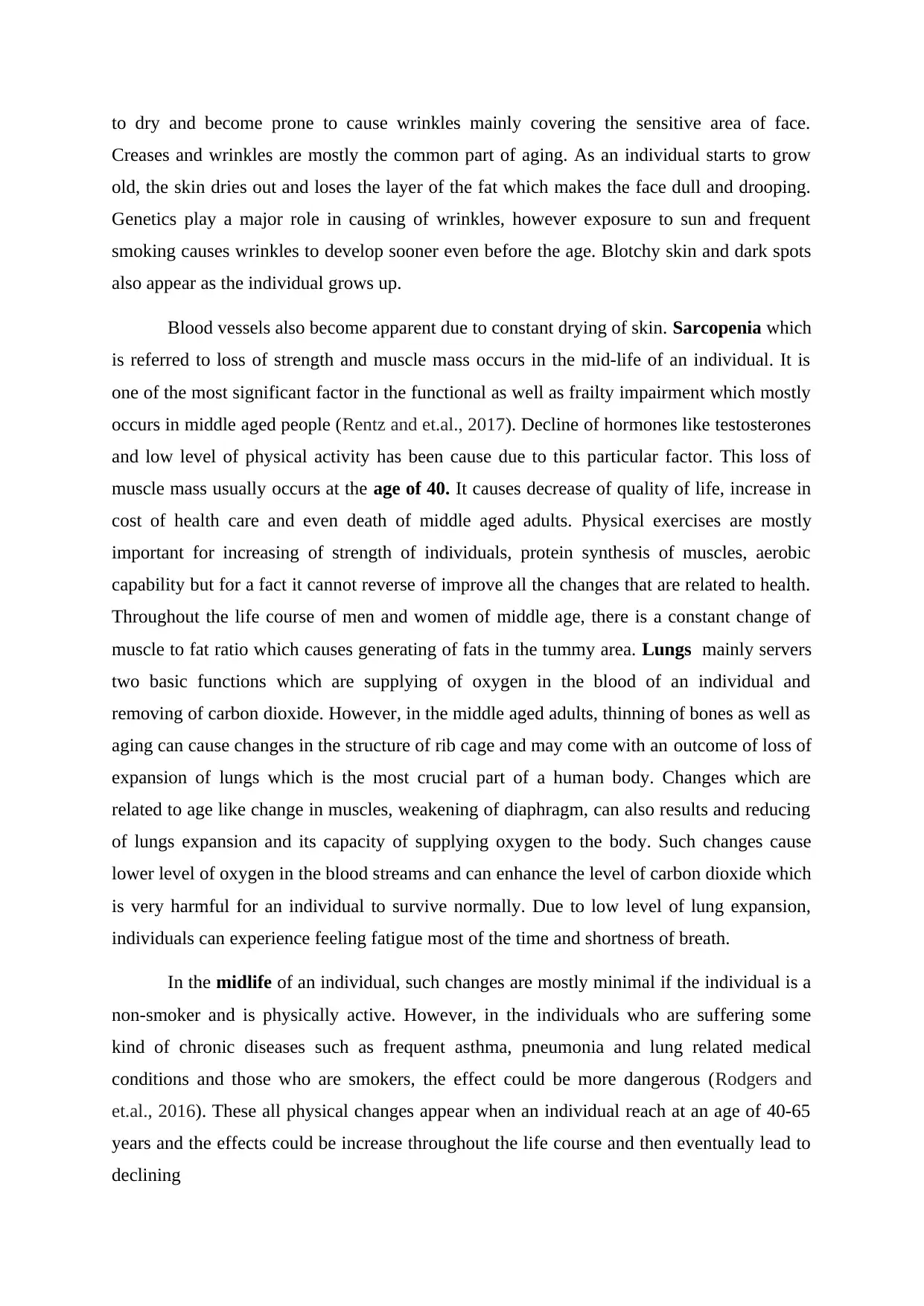
to dry and become prone to cause wrinkles mainly covering the sensitive area of face.
Creases and wrinkles are mostly the common part of aging. As an individual starts to grow
old, the skin dries out and loses the layer of the fat which makes the face dull and drooping.
Genetics play a major role in causing of wrinkles, however exposure to sun and frequent
smoking causes wrinkles to develop sooner even before the age. Blotchy skin and dark spots
also appear as the individual grows up.
Blood vessels also become apparent due to constant drying of skin. Sarcopenia which
is referred to loss of strength and muscle mass occurs in the mid-life of an individual. It is
one of the most significant factor in the functional as well as frailty impairment which mostly
occurs in middle aged people (Rentz and et.al., 2017). Decline of hormones like testosterones
and low level of physical activity has been cause due to this particular factor. This loss of
muscle mass usually occurs at the age of 40. It causes decrease of quality of life, increase in
cost of health care and even death of middle aged adults. Physical exercises are mostly
important for increasing of strength of individuals, protein synthesis of muscles, aerobic
capability but for a fact it cannot reverse of improve all the changes that are related to health.
Throughout the life course of men and women of middle age, there is a constant change of
muscle to fat ratio which causes generating of fats in the tummy area. Lungs mainly servers
two basic functions which are supplying of oxygen in the blood of an individual and
removing of carbon dioxide. However, in the middle aged adults, thinning of bones as well as
aging can cause changes in the structure of rib cage and may come with an outcome of loss of
expansion of lungs which is the most crucial part of a human body. Changes which are
related to age like change in muscles, weakening of diaphragm, can also results and reducing
of lungs expansion and its capacity of supplying oxygen to the body. Such changes cause
lower level of oxygen in the blood streams and can enhance the level of carbon dioxide which
is very harmful for an individual to survive normally. Due to low level of lung expansion,
individuals can experience feeling fatigue most of the time and shortness of breath.
In the midlife of an individual, such changes are mostly minimal if the individual is a
non-smoker and is physically active. However, in the individuals who are suffering some
kind of chronic diseases such as frequent asthma, pneumonia and lung related medical
conditions and those who are smokers, the effect could be more dangerous (Rodgers and
et.al., 2016). These all physical changes appear when an individual reach at an age of 40-65
years and the effects could be increase throughout the life course and then eventually lead to
declining
Creases and wrinkles are mostly the common part of aging. As an individual starts to grow
old, the skin dries out and loses the layer of the fat which makes the face dull and drooping.
Genetics play a major role in causing of wrinkles, however exposure to sun and frequent
smoking causes wrinkles to develop sooner even before the age. Blotchy skin and dark spots
also appear as the individual grows up.
Blood vessels also become apparent due to constant drying of skin. Sarcopenia which
is referred to loss of strength and muscle mass occurs in the mid-life of an individual. It is
one of the most significant factor in the functional as well as frailty impairment which mostly
occurs in middle aged people (Rentz and et.al., 2017). Decline of hormones like testosterones
and low level of physical activity has been cause due to this particular factor. This loss of
muscle mass usually occurs at the age of 40. It causes decrease of quality of life, increase in
cost of health care and even death of middle aged adults. Physical exercises are mostly
important for increasing of strength of individuals, protein synthesis of muscles, aerobic
capability but for a fact it cannot reverse of improve all the changes that are related to health.
Throughout the life course of men and women of middle age, there is a constant change of
muscle to fat ratio which causes generating of fats in the tummy area. Lungs mainly servers
two basic functions which are supplying of oxygen in the blood of an individual and
removing of carbon dioxide. However, in the middle aged adults, thinning of bones as well as
aging can cause changes in the structure of rib cage and may come with an outcome of loss of
expansion of lungs which is the most crucial part of a human body. Changes which are
related to age like change in muscles, weakening of diaphragm, can also results and reducing
of lungs expansion and its capacity of supplying oxygen to the body. Such changes cause
lower level of oxygen in the blood streams and can enhance the level of carbon dioxide which
is very harmful for an individual to survive normally. Due to low level of lung expansion,
individuals can experience feeling fatigue most of the time and shortness of breath.
In the midlife of an individual, such changes are mostly minimal if the individual is a
non-smoker and is physically active. However, in the individuals who are suffering some
kind of chronic diseases such as frequent asthma, pneumonia and lung related medical
conditions and those who are smokers, the effect could be more dangerous (Rodgers and
et.al., 2016). These all physical changes appear when an individual reach at an age of 40-65
years and the effects could be increase throughout the life course and then eventually lead to
declining
Secure Best Marks with AI Grader
Need help grading? Try our AI Grader for instant feedback on your assignments.
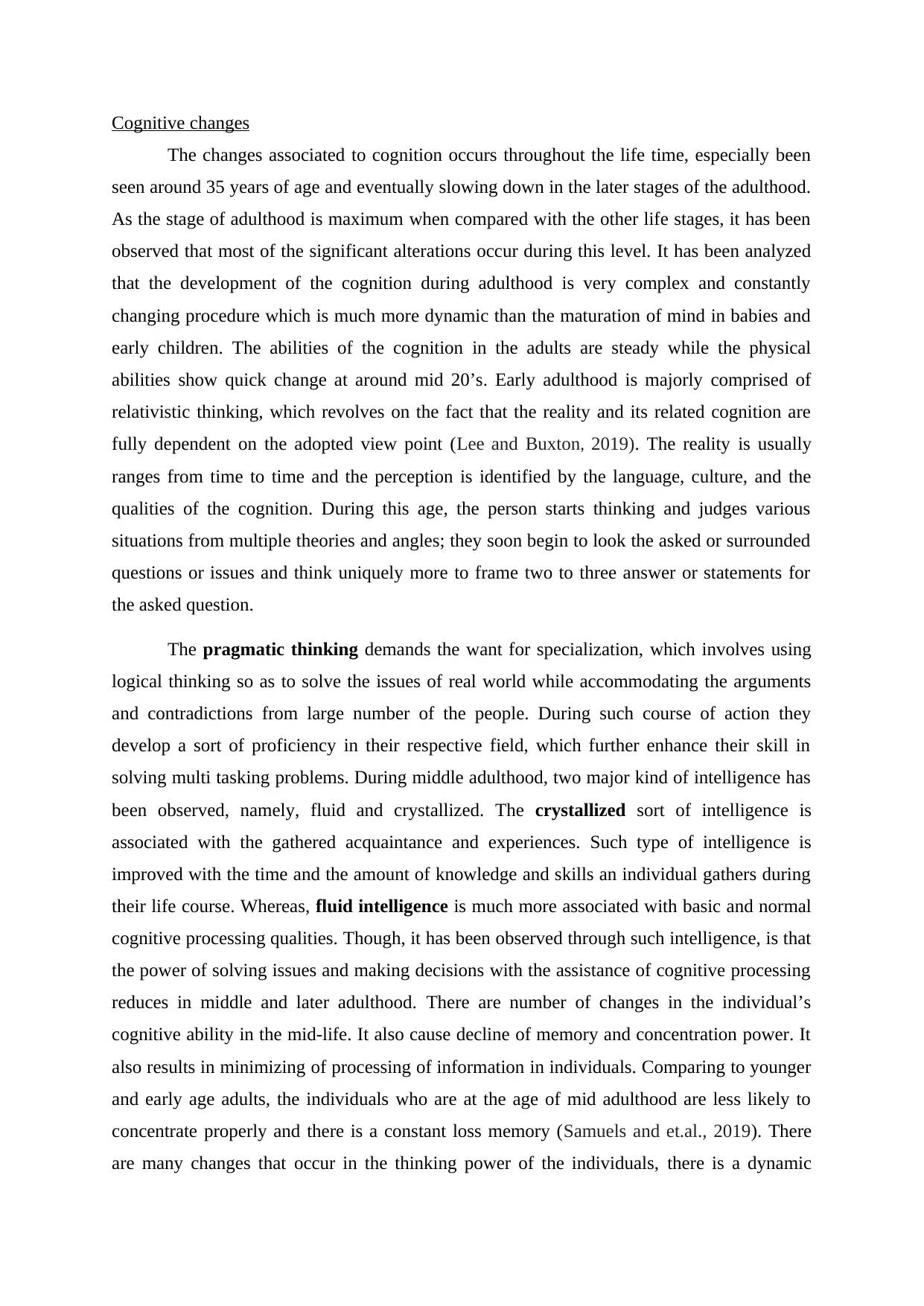
Cognitive changes
The changes associated to cognition occurs throughout the life time, especially been
seen around 35 years of age and eventually slowing down in the later stages of the adulthood.
As the stage of adulthood is maximum when compared with the other life stages, it has been
observed that most of the significant alterations occur during this level. It has been analyzed
that the development of the cognition during adulthood is very complex and constantly
changing procedure which is much more dynamic than the maturation of mind in babies and
early children. The abilities of the cognition in the adults are steady while the physical
abilities show quick change at around mid 20’s. Early adulthood is majorly comprised of
relativistic thinking, which revolves on the fact that the reality and its related cognition are
fully dependent on the adopted view point (Lee and Buxton, 2019). The reality is usually
ranges from time to time and the perception is identified by the language, culture, and the
qualities of the cognition. During this age, the person starts thinking and judges various
situations from multiple theories and angles; they soon begin to look the asked or surrounded
questions or issues and think uniquely more to frame two to three answer or statements for
the asked question.
The pragmatic thinking demands the want for specialization, which involves using
logical thinking so as to solve the issues of real world while accommodating the arguments
and contradictions from large number of the people. During such course of action they
develop a sort of proficiency in their respective field, which further enhance their skill in
solving multi tasking problems. During middle adulthood, two major kind of intelligence has
been observed, namely, fluid and crystallized. The crystallized sort of intelligence is
associated with the gathered acquaintance and experiences. Such type of intelligence is
improved with the time and the amount of knowledge and skills an individual gathers during
their life course. Whereas, fluid intelligence is much more associated with basic and normal
cognitive processing qualities. Though, it has been observed through such intelligence, is that
the power of solving issues and making decisions with the assistance of cognitive processing
reduces in middle and later adulthood. There are number of changes in the individual’s
cognitive ability in the mid-life. It also cause decline of memory and concentration power. It
also results in minimizing of processing of information in individuals. Comparing to younger
and early age adults, the individuals who are at the age of mid adulthood are less likely to
concentrate properly and there is a constant loss memory (Samuels and et.al., 2019). There
are many changes that occur in the thinking power of the individuals, there is a dynamic
The changes associated to cognition occurs throughout the life time, especially been
seen around 35 years of age and eventually slowing down in the later stages of the adulthood.
As the stage of adulthood is maximum when compared with the other life stages, it has been
observed that most of the significant alterations occur during this level. It has been analyzed
that the development of the cognition during adulthood is very complex and constantly
changing procedure which is much more dynamic than the maturation of mind in babies and
early children. The abilities of the cognition in the adults are steady while the physical
abilities show quick change at around mid 20’s. Early adulthood is majorly comprised of
relativistic thinking, which revolves on the fact that the reality and its related cognition are
fully dependent on the adopted view point (Lee and Buxton, 2019). The reality is usually
ranges from time to time and the perception is identified by the language, culture, and the
qualities of the cognition. During this age, the person starts thinking and judges various
situations from multiple theories and angles; they soon begin to look the asked or surrounded
questions or issues and think uniquely more to frame two to three answer or statements for
the asked question.
The pragmatic thinking demands the want for specialization, which involves using
logical thinking so as to solve the issues of real world while accommodating the arguments
and contradictions from large number of the people. During such course of action they
develop a sort of proficiency in their respective field, which further enhance their skill in
solving multi tasking problems. During middle adulthood, two major kind of intelligence has
been observed, namely, fluid and crystallized. The crystallized sort of intelligence is
associated with the gathered acquaintance and experiences. Such type of intelligence is
improved with the time and the amount of knowledge and skills an individual gathers during
their life course. Whereas, fluid intelligence is much more associated with basic and normal
cognitive processing qualities. Though, it has been observed through such intelligence, is that
the power of solving issues and making decisions with the assistance of cognitive processing
reduces in middle and later adulthood. There are number of changes in the individual’s
cognitive ability in the mid-life. It also cause decline of memory and concentration power. It
also results in minimizing of processing of information in individuals. Comparing to younger
and early age adults, the individuals who are at the age of mid adulthood are less likely to
concentrate properly and there is a constant loss memory (Samuels and et.al., 2019). There
are many changes that occur in the thinking power of the individuals, there is a dynamic
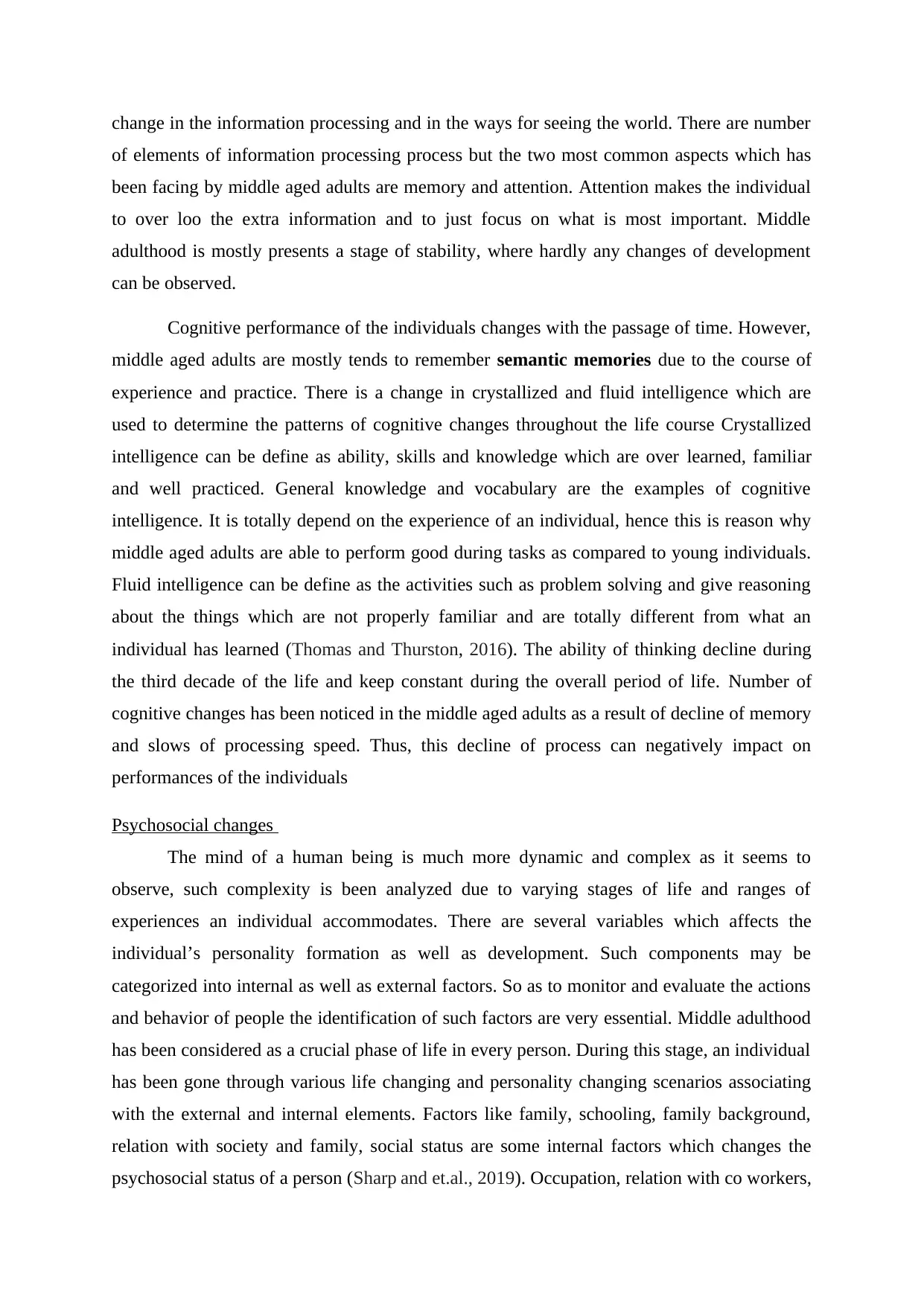
change in the information processing and in the ways for seeing the world. There are number
of elements of information processing process but the two most common aspects which has
been facing by middle aged adults are memory and attention. Attention makes the individual
to over loo the extra information and to just focus on what is most important. Middle
adulthood is mostly presents a stage of stability, where hardly any changes of development
can be observed.
Cognitive performance of the individuals changes with the passage of time. However,
middle aged adults are mostly tends to remember semantic memories due to the course of
experience and practice. There is a change in crystallized and fluid intelligence which are
used to determine the patterns of cognitive changes throughout the life course Crystallized
intelligence can be define as ability, skills and knowledge which are over learned, familiar
and well practiced. General knowledge and vocabulary are the examples of cognitive
intelligence. It is totally depend on the experience of an individual, hence this is reason why
middle aged adults are able to perform good during tasks as compared to young individuals.
Fluid intelligence can be define as the activities such as problem solving and give reasoning
about the things which are not properly familiar and are totally different from what an
individual has learned (Thomas and Thurston, 2016). The ability of thinking decline during
the third decade of the life and keep constant during the overall period of life. Number of
cognitive changes has been noticed in the middle aged adults as a result of decline of memory
and slows of processing speed. Thus, this decline of process can negatively impact on
performances of the individuals
Psychosocial changes
The mind of a human being is much more dynamic and complex as it seems to
observe, such complexity is been analyzed due to varying stages of life and ranges of
experiences an individual accommodates. There are several variables which affects the
individual’s personality formation as well as development. Such components may be
categorized into internal as well as external factors. So as to monitor and evaluate the actions
and behavior of people the identification of such factors are very essential. Middle adulthood
has been considered as a crucial phase of life in every person. During this stage, an individual
has been gone through various life changing and personality changing scenarios associating
with the external and internal elements. Factors like family, schooling, family background,
relation with society and family, social status are some internal factors which changes the
psychosocial status of a person (Sharp and et.al., 2019). Occupation, relation with co workers,
of elements of information processing process but the two most common aspects which has
been facing by middle aged adults are memory and attention. Attention makes the individual
to over loo the extra information and to just focus on what is most important. Middle
adulthood is mostly presents a stage of stability, where hardly any changes of development
can be observed.
Cognitive performance of the individuals changes with the passage of time. However,
middle aged adults are mostly tends to remember semantic memories due to the course of
experience and practice. There is a change in crystallized and fluid intelligence which are
used to determine the patterns of cognitive changes throughout the life course Crystallized
intelligence can be define as ability, skills and knowledge which are over learned, familiar
and well practiced. General knowledge and vocabulary are the examples of cognitive
intelligence. It is totally depend on the experience of an individual, hence this is reason why
middle aged adults are able to perform good during tasks as compared to young individuals.
Fluid intelligence can be define as the activities such as problem solving and give reasoning
about the things which are not properly familiar and are totally different from what an
individual has learned (Thomas and Thurston, 2016). The ability of thinking decline during
the third decade of the life and keep constant during the overall period of life. Number of
cognitive changes has been noticed in the middle aged adults as a result of decline of memory
and slows of processing speed. Thus, this decline of process can negatively impact on
performances of the individuals
Psychosocial changes
The mind of a human being is much more dynamic and complex as it seems to
observe, such complexity is been analyzed due to varying stages of life and ranges of
experiences an individual accommodates. There are several variables which affects the
individual’s personality formation as well as development. Such components may be
categorized into internal as well as external factors. So as to monitor and evaluate the actions
and behavior of people the identification of such factors are very essential. Middle adulthood
has been considered as a crucial phase of life in every person. During this stage, an individual
has been gone through various life changing and personality changing scenarios associating
with the external and internal elements. Factors like family, schooling, family background,
relation with society and family, social status are some internal factors which changes the
psychosocial status of a person (Sharp and et.al., 2019). Occupation, relation with co workers,
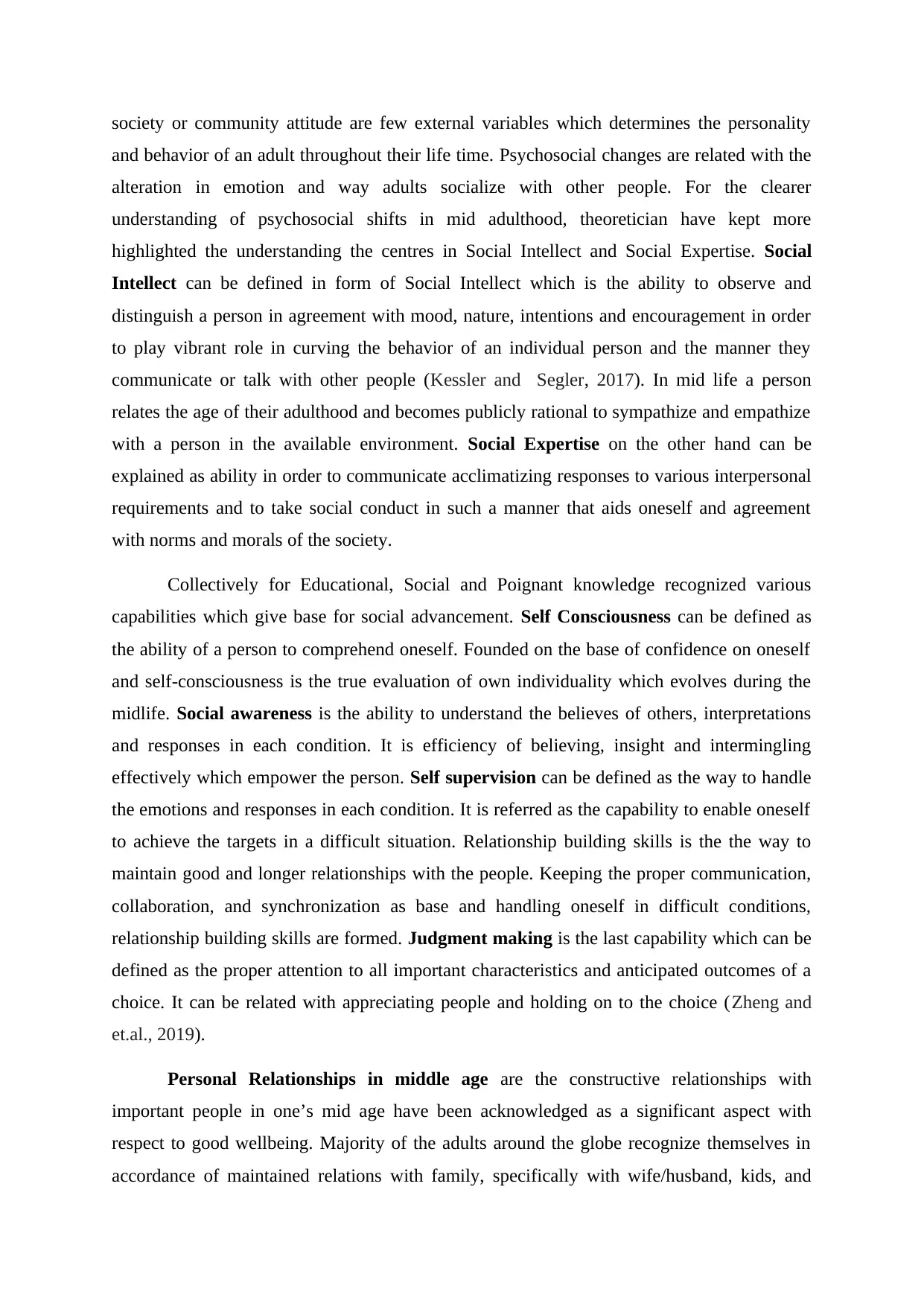
society or community attitude are few external variables which determines the personality
and behavior of an adult throughout their life time. Psychosocial changes are related with the
alteration in emotion and way adults socialize with other people. For the clearer
understanding of psychosocial shifts in mid adulthood, theoretician have kept more
highlighted the understanding the centres in Social Intellect and Social Expertise. Social
Intellect can be defined in form of Social Intellect which is the ability to observe and
distinguish a person in agreement with mood, nature, intentions and encouragement in order
to play vibrant role in curving the behavior of an individual person and the manner they
communicate or talk with other people (Kessler and Segler, 2017). In mid life a person
relates the age of their adulthood and becomes publicly rational to sympathize and empathize
with a person in the available environment. Social Expertise on the other hand can be
explained as ability in order to communicate acclimatizing responses to various interpersonal
requirements and to take social conduct in such a manner that aids oneself and agreement
with norms and morals of the society.
Collectively for Educational, Social and Poignant knowledge recognized various
capabilities which give base for social advancement. Self Consciousness can be defined as
the ability of a person to comprehend oneself. Founded on the base of confidence on oneself
and self-consciousness is the true evaluation of own individuality which evolves during the
midlife. Social awareness is the ability to understand the believes of others, interpretations
and responses in each condition. It is efficiency of believing, insight and intermingling
effectively which empower the person. Self supervision can be defined as the way to handle
the emotions and responses in each condition. It is referred as the capability to enable oneself
to achieve the targets in a difficult situation. Relationship building skills is the the way to
maintain good and longer relationships with the people. Keeping the proper communication,
collaboration, and synchronization as base and handling oneself in difficult conditions,
relationship building skills are formed. Judgment making is the last capability which can be
defined as the proper attention to all important characteristics and anticipated outcomes of a
choice. It can be related with appreciating people and holding on to the choice (Zheng and
et.al., 2019).
Personal Relationships in middle age are the constructive relationships with
important people in one’s mid age have been acknowledged as a significant aspect with
respect to good wellbeing. Majority of the adults around the globe recognize themselves in
accordance of maintained relations with family, specifically with wife/husband, kids, and
and behavior of an adult throughout their life time. Psychosocial changes are related with the
alteration in emotion and way adults socialize with other people. For the clearer
understanding of psychosocial shifts in mid adulthood, theoretician have kept more
highlighted the understanding the centres in Social Intellect and Social Expertise. Social
Intellect can be defined in form of Social Intellect which is the ability to observe and
distinguish a person in agreement with mood, nature, intentions and encouragement in order
to play vibrant role in curving the behavior of an individual person and the manner they
communicate or talk with other people (Kessler and Segler, 2017). In mid life a person
relates the age of their adulthood and becomes publicly rational to sympathize and empathize
with a person in the available environment. Social Expertise on the other hand can be
explained as ability in order to communicate acclimatizing responses to various interpersonal
requirements and to take social conduct in such a manner that aids oneself and agreement
with norms and morals of the society.
Collectively for Educational, Social and Poignant knowledge recognized various
capabilities which give base for social advancement. Self Consciousness can be defined as
the ability of a person to comprehend oneself. Founded on the base of confidence on oneself
and self-consciousness is the true evaluation of own individuality which evolves during the
midlife. Social awareness is the ability to understand the believes of others, interpretations
and responses in each condition. It is efficiency of believing, insight and intermingling
effectively which empower the person. Self supervision can be defined as the way to handle
the emotions and responses in each condition. It is referred as the capability to enable oneself
to achieve the targets in a difficult situation. Relationship building skills is the the way to
maintain good and longer relationships with the people. Keeping the proper communication,
collaboration, and synchronization as base and handling oneself in difficult conditions,
relationship building skills are formed. Judgment making is the last capability which can be
defined as the proper attention to all important characteristics and anticipated outcomes of a
choice. It can be related with appreciating people and holding on to the choice (Zheng and
et.al., 2019).
Personal Relationships in middle age are the constructive relationships with
important people in one’s mid age have been acknowledged as a significant aspect with
respect to good wellbeing. Majority of the adults around the globe recognize themselves in
accordance of maintained relations with family, specifically with wife/husband, kids, and
Paraphrase This Document
Need a fresh take? Get an instant paraphrase of this document with our AI Paraphraser
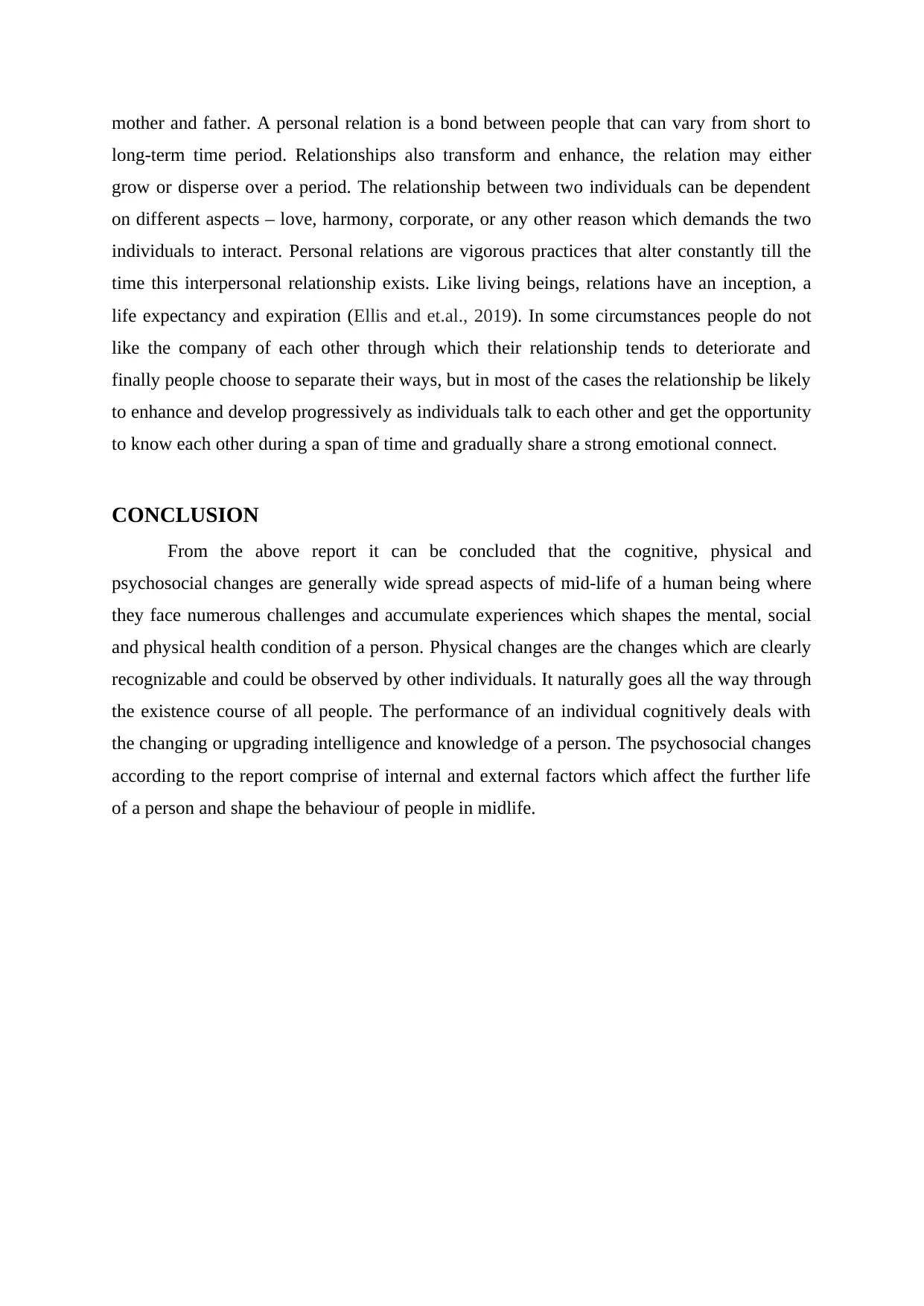
mother and father. A personal relation is a bond between people that can vary from short to
long-term time period. Relationships also transform and enhance, the relation may either
grow or disperse over a period. The relationship between two individuals can be dependent
on different aspects – love, harmony, corporate, or any other reason which demands the two
individuals to interact. Personal relations are vigorous practices that alter constantly till the
time this interpersonal relationship exists. Like living beings, relations have an inception, a
life expectancy and expiration (Ellis and et.al., 2019). In some circumstances people do not
like the company of each other through which their relationship tends to deteriorate and
finally people choose to separate their ways, but in most of the cases the relationship be likely
to enhance and develop progressively as individuals talk to each other and get the opportunity
to know each other during a span of time and gradually share a strong emotional connect.
CONCLUSION
From the above report it can be concluded that the cognitive, physical and
psychosocial changes are generally wide spread aspects of mid-life of a human being where
they face numerous challenges and accumulate experiences which shapes the mental, social
and physical health condition of a person. Physical changes are the changes which are clearly
recognizable and could be observed by other individuals. It naturally goes all the way through
the existence course of all people. The performance of an individual cognitively deals with
the changing or upgrading intelligence and knowledge of a person. The psychosocial changes
according to the report comprise of internal and external factors which affect the further life
of a person and shape the behaviour of people in midlife.
long-term time period. Relationships also transform and enhance, the relation may either
grow or disperse over a period. The relationship between two individuals can be dependent
on different aspects – love, harmony, corporate, or any other reason which demands the two
individuals to interact. Personal relations are vigorous practices that alter constantly till the
time this interpersonal relationship exists. Like living beings, relations have an inception, a
life expectancy and expiration (Ellis and et.al., 2019). In some circumstances people do not
like the company of each other through which their relationship tends to deteriorate and
finally people choose to separate their ways, but in most of the cases the relationship be likely
to enhance and develop progressively as individuals talk to each other and get the opportunity
to know each other during a span of time and gradually share a strong emotional connect.
CONCLUSION
From the above report it can be concluded that the cognitive, physical and
psychosocial changes are generally wide spread aspects of mid-life of a human being where
they face numerous challenges and accumulate experiences which shapes the mental, social
and physical health condition of a person. Physical changes are the changes which are clearly
recognizable and could be observed by other individuals. It naturally goes all the way through
the existence course of all people. The performance of an individual cognitively deals with
the changing or upgrading intelligence and knowledge of a person. The psychosocial changes
according to the report comprise of internal and external factors which affect the further life
of a person and shape the behaviour of people in midlife.

REFERENCES
Books and Journals
El Khoudary, S.R and et.al., 2019. The menopause transition and women's health at midlife: a
progress report from the Study of Women's Health Across the Nation (SWAN). Menopause
(New York, NY). 26(10). p.1213.
Ellis, E.M and et.al., 2019. Direct and indirect associations of cognitive reappraisal and
suppression with disease biomarkers. Psychology & health. 34(3). pp.336-354.
Kessler, E.M., Kessler, E.-M./Bowen, C. N and Segler, J.(2017). Dementia Worry in Middle-
aged and Older Adults in Germany: Sociodemographic, Health-related and Psychological
Correlates. European Journal of Ageing (advance online publication, doi: 10.1007/s10433-
018-0462-7).
Krychman, M.L., 2017. Declining sexuality at midlife. Menopause. 24(4). pp.358-359.
Lee, S. and Buxton, O.M., 2019. PSYCHOLOGICAL AND SOCIAL FACTORS
ASSOCIATED WITH SLEEP HEALTH ACROSS ADULTHOOD. Innovation in
Aging, 3(Supplement_1). pp.S778-S778.
Paine, E.A.,and et.al., 2019. Sex in Midlife: Women's Sexual Experiences in Lesbian and
Straight Marriages. Journal of Marriage and Family. 81(1). pp.7-23.
Rentz, D.M. and et.al., 2017. Sex differences in episodic memory in early midlife: impact of
reproductive aging. Menopause (New York, NY), 24(4). p.400.
Rodgers, R.F.,and et.al., 2016. “Does the voice in your head get kinder as you get older?”
Women’s perceptions of body image in midlife. Journal of women & aging. 28(5). pp.395-
402.
Samuels, K.L.,and et.al., 2019. Disordered eating, eating disorders, and body image in
midlife and older women. Current psychiatry reports. 21(8). p.70.
Sharp, E.S and et.al., 2019. Openness declines in advance of death in late
adulthood. Psychology and aging. 34(1). p.124.
Thomas, H.N. and Thurston, R.C., 2016. A biopsychosocial approach to women’s sexual
function and dysfunction at midlife: A narrative review. Maturitas. 87. pp.49-60.
Zheng, M and et.al., 2019. A Model for Physical Activity Behavioural Change in Middle
Aged and Older People with Type 2 Diabetes. In E3S Web of Conferences (Vol. 78, p.
01010). EDP Sciences.
Books and Journals
El Khoudary, S.R and et.al., 2019. The menopause transition and women's health at midlife: a
progress report from the Study of Women's Health Across the Nation (SWAN). Menopause
(New York, NY). 26(10). p.1213.
Ellis, E.M and et.al., 2019. Direct and indirect associations of cognitive reappraisal and
suppression with disease biomarkers. Psychology & health. 34(3). pp.336-354.
Kessler, E.M., Kessler, E.-M./Bowen, C. N and Segler, J.(2017). Dementia Worry in Middle-
aged and Older Adults in Germany: Sociodemographic, Health-related and Psychological
Correlates. European Journal of Ageing (advance online publication, doi: 10.1007/s10433-
018-0462-7).
Krychman, M.L., 2017. Declining sexuality at midlife. Menopause. 24(4). pp.358-359.
Lee, S. and Buxton, O.M., 2019. PSYCHOLOGICAL AND SOCIAL FACTORS
ASSOCIATED WITH SLEEP HEALTH ACROSS ADULTHOOD. Innovation in
Aging, 3(Supplement_1). pp.S778-S778.
Paine, E.A.,and et.al., 2019. Sex in Midlife: Women's Sexual Experiences in Lesbian and
Straight Marriages. Journal of Marriage and Family. 81(1). pp.7-23.
Rentz, D.M. and et.al., 2017. Sex differences in episodic memory in early midlife: impact of
reproductive aging. Menopause (New York, NY), 24(4). p.400.
Rodgers, R.F.,and et.al., 2016. “Does the voice in your head get kinder as you get older?”
Women’s perceptions of body image in midlife. Journal of women & aging. 28(5). pp.395-
402.
Samuels, K.L.,and et.al., 2019. Disordered eating, eating disorders, and body image in
midlife and older women. Current psychiatry reports. 21(8). p.70.
Sharp, E.S and et.al., 2019. Openness declines in advance of death in late
adulthood. Psychology and aging. 34(1). p.124.
Thomas, H.N. and Thurston, R.C., 2016. A biopsychosocial approach to women’s sexual
function and dysfunction at midlife: A narrative review. Maturitas. 87. pp.49-60.
Zheng, M and et.al., 2019. A Model for Physical Activity Behavioural Change in Middle
Aged and Older People with Type 2 Diabetes. In E3S Web of Conferences (Vol. 78, p.
01010). EDP Sciences.
1 out of 9
Related Documents
Your All-in-One AI-Powered Toolkit for Academic Success.
+13062052269
info@desklib.com
Available 24*7 on WhatsApp / Email
![[object Object]](/_next/static/media/star-bottom.7253800d.svg)
Unlock your academic potential
© 2024 | Zucol Services PVT LTD | All rights reserved.





